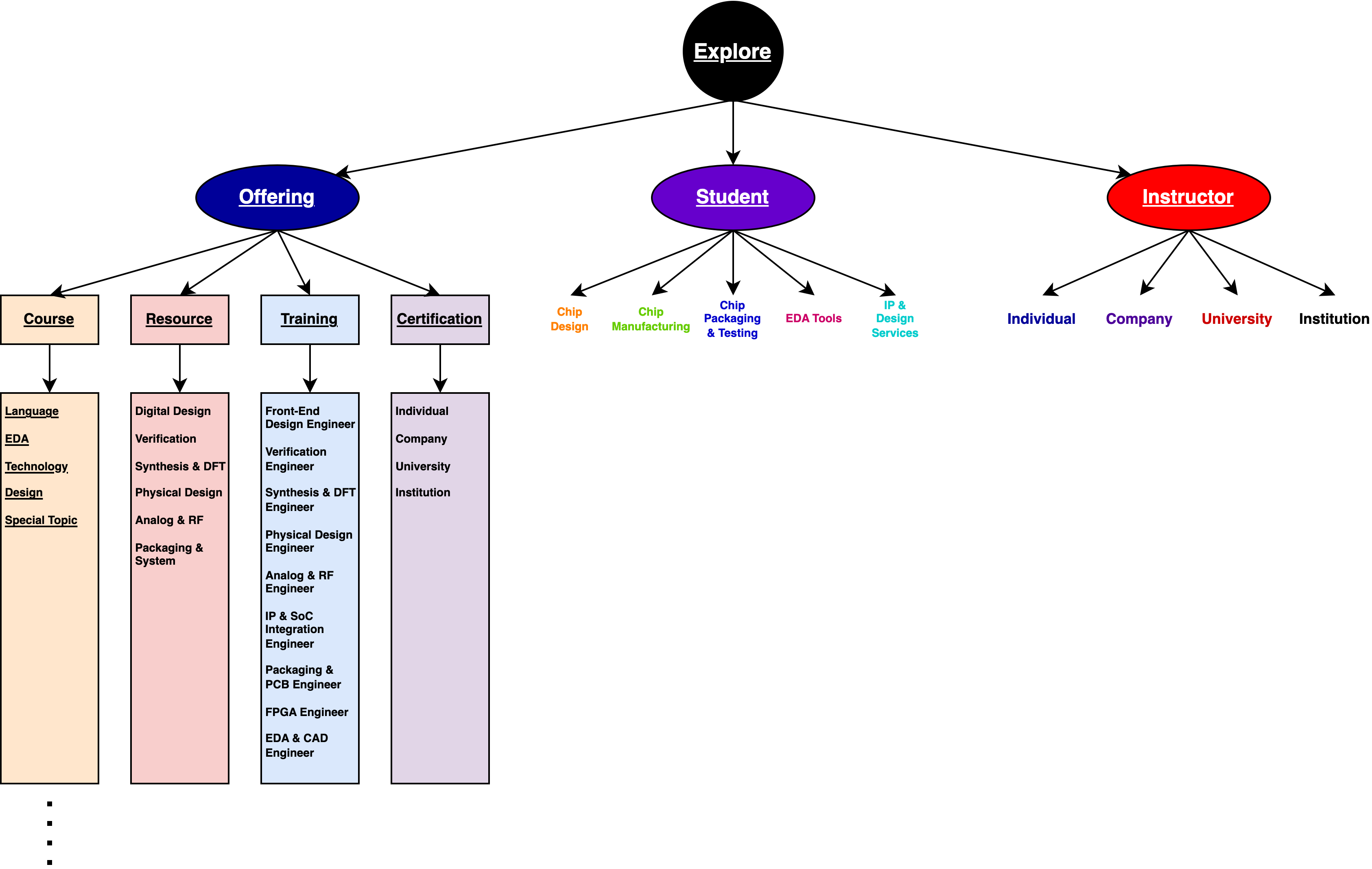Uncover the platform’s full coverage through layered exploration. Begin with a panoramic view, then drill into the segments most relevant to you—whether you’re selecting what to learn, whom to learn from, or how to participate as a contributor—while keeping sight of the bigger picture.
EDA Academy presents a professionally structured catalog that spans the entire IC landscape. Four product lines anchor the collection—Courses, Resources, Trainings, and Certifications—each built to support exploration, depth, and recognition.
Courses follow coherent tracks: Language foundations, applied EDA practice, evolving Technology context, Design decision-making, and Special Topic focus areas. This sequence helps learners move from shared vocabulary to repeatable methods, informed choices, and targeted specializations.
Complementing every track, Resources provide concise, high-signal references across Digital Design, Verification, Synthesis & DFT, Physical Design, Analog & RF, and Packaging & System. They’re designed for quick orientation, deeper reading, and immediate reuse in real work.
For outcome-driven development, Trainings align to role pathways: Front-End Design Engineer, Verification Engineer, Synthesis & DFT Engineer, Physical Design Engineer, Analog & RF Engineer, IP & SoC Integration Engineer, Packaging & PCB Engineer, FPGA Engineer, and EDA & CAD Engineer. Each pathway clarifies objectives, milestones, and readiness.
When formal recognition is needed, Certifications are issued by diverse providers—Individuals, Companies, Universities, and Institutions—with transparent scope definitions, evidence requirements, and review timelines.
Together, these product lines turn breadth into a clear learning and validation system: discover what to study, develop mastery in sequence, prepare for specific roles, and document achievement with credible credentials.
EDA Academy presents students through technical-domain classifications that describe where their expertise is developing. Each registered student can associate with one or more domains—Chip Design, Chip Manufacturing, Chip Packaging & Testing, EDA Tools, and IP & Design Services—so visitors immediately understand the technical scope of their learning.
Public profiles convert study into clear professional signals. A concise headline and domain badges frame positioning; a skills section maps competencies to the selected domains; a progress timeline records enrollments and completions; assessment results and issued credentials appear in a dedicated recognition area. Where enabled, brief project summaries and selected artifacts document practical outcomes to strengthen credibility.
The presentation is designed for both scanning and depth. Domain filters and sort options surface relevant profiles quickly; standardized sections make comparisons fair; inline summaries keep context while deeper pages provide full detail. Students control which sections are visible to align with career goals and privacy needs.
By anchoring profiles to these technical domains—and consistently mapping skills, milestones, and recognition to each—EDA Academy communicates what students are learning, how far they have progressed, and in which parts of the industry they are ready to contribute. The result is a professional showcase that raises visibility, signals domain readiness, and supports reputation building across the ecosystem.
On EDA Academy, every offering originates from a registered instructor entity—the formal source behind the teaching. The platform supports four instructor types that map to real-world providers of knowledge: Individual Instructor Entity (a solo expert), Company Instructor Entity (an enterprise or team), University Instructor Entity (an academic department or group), and Institution Instructor Entity (a research or industry body). This classification makes it explicit who teaches what, and from which perspective the instruction is delivered.
Registration is open to all four types: individuals register as an Individual Instructor Entity; companies, universities, and institutions register under their corresponding entity types. Approval focuses on the clarity, correctness, and usefulness of the proposed content rather than production polish, so qualified contributors can move quickly from intent to instruction. Once approved, the entity becomes the named provider of any courses, resources, or trainings it publishes and, where applicable, the issuer of certifications aligned to its scope.
Recognizing multiple instructor entities ensures broad participation across the IC landscape while preserving provenance and accountability. Learners can understand the origin of each offering—whether it reflects hands-on practice from an individual expert, operational knowledge from a company, curricular depth from a university, or cross-industry guidance from an institution. This simple, transparent model encourages high-value contributions from diverse sources and sustains a professional marketplace of instruction grounded in expertise.
The document will be emailed to you. Please check your Spam folder if it doesn’t appear in your inbox.
We HATE spam. Your email address is 100% secure

